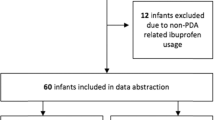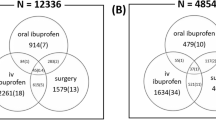Abstract
Objective:
To review intestinal complications associated with ibuprofen treatment of patent ductus arteriosus (PDA).
Study Design:
Data from preterm infants treated with ibuprofen were retrospectively reviewed. χ2 test and Fischer's exact test were used for univariate analyses. Multivariate analyses with logistic regression modeling were used to identify risk factors.
Result:
One hundred and two infants were treated with ibuprofen for PDA. Nine (9/102, 8.8%) infants developed spontaneous intestinal perforation (SIP), whereas 93/102 (91.2%) did not. The mean (±s.d.) gestational age (GA) at birth in infants with and without SIP was 25.2 (±1.3) vs 27.6 (±2.4) weeks (P=0.02) and the median (interquartile) length of stay (LOS) was 109.5 (91.0 to 116.5) vs 75.0 (53.0 to 94.5) days (P=0.002), respectively. The mean (±s.d.) age at starting ibuprofen was 3.3 (±1.3) vs 5.8 (±3.5) days in infants with and without SIP, respectively (P=0.03). In logistic regression analyses, increasing GA and later initiation of ibuprofen treatment were protective against risk of SIP; odds ratio, 95% confidence interval (OR, 95% CI)=0.26 (0.09 to 0.75), P=0.01 and 0.63 (0.41 to 0.95), P=0.03, respectively.
Conclusion:
Infants at lower GA are at risk of SIP when treated early with ibuprofen for symptomatic PDA.
This is a preview of subscription content, access via your institution
Access options
Subscribe to this journal
Receive 12 print issues and online access
$259.00 per year
only $21.58 per issue
Buy this article
- Purchase on Springer Link
- Instant access to full article PDF
Prices may be subject to local taxes which are calculated during checkout
Similar content being viewed by others
References
Fowlie PW, Davis PG . Prophylactic indomethacin for preterm infants: a systematic review and meta-analysis. Arch Dis Child Fetal Neonatal Ed 2003; 88 (6): F464–F466.
Fowlie PW, Davis PG, McGuire W . Prophylactic intravenous indomethacin for preventing mortality and morbidity in preterm infants. Cochrane Database Syst Rev 2010; CD000174.
Ment LR, Vohr BR, Makuch RW, Westerveld M, Katz KH, Schneider KC et al. Prevention of intraventricular hemorrhage by indomethacin in male preterm infants. J Pediatr 2004; 145 (6): 832–834.
Chorne N, Leonard C, Piecuch R, Clyman RI . Patent ductus arteriosus and its treatment as risk factors for neonatal and neurodevelopmental morbidity. Pediatrics 2007; 119 (6): 1165–1174.
Bose CL, Laughon MM . Patent ductus arteriosus: lack of evidence for common treatments. Arch Dis Child Fetal Neonatal Ed 2007; 92 (6): F498–F502.
Benitz WE . Treatment of persistent patent ductus arteriosus in preterm infants: time to accept the null hypothesis? J Perinatol 2010; 30 (4): 241–252.
Van Overmeire B, Smets K, Lecoutere D, Van de Broek H, Weyler J, Degroote K et al. A comparison of ibuprofen and indomethacin for closure of patent ductus arteriosus. N Engl J Med 2000; 343 (10): 674–681.
Su BH, Lin HC, Chiu HY, Hsieh HY, Chen HH, Tsai YC . Comparison of ibuprofen and indomethacin for early-targeted treatment of patent ductus arteriosus in extremely premature infants: a randomised controlled trial. Arch Dis Child Fetal Neonatal Ed 2008; 93 (2): F94–F99.
Aranda JV, Thomas R . Systematic review: intravenous ibuprofen in preterm newborns. Semin Perinatol 2006; 30 (3): 114–120.
Alpan G, Eyal F, Vinograd I, Udassin R, Amir G, Mogle P et al. Localized intestinal perforations after enteral administration of indomethacin in premature infants. J Pediatr 1985; 106 (2): 277–281.
Knight DB . The treatment of patent ductus arteriosus in preterm infants. A review and overview of randomized trials. Semin Neonatol 2001; 6 (1): 63–73.
Nagaraj HS, Sandhu AS, Cook LN, Buchino JJ, Groff DB . Gastrointestinal perforation following indomethacin therapy in very low birth weight infants. J Pediatr Surg 1981; 16 (6): 1003–1007.
Aschner JL, Deluga KS, Metlay LA, Emmens RW, Hendricks-Munoz KD . Spontaneous focal gastrointestinal perforation in very low birth weight infants. J Pediatr 1988; 113 (2): 364–367.
Attridge JT, Clark R, Walker MW, Gordon PV . New insights into spontaneous intestinal perforation using a national data set: (2) two populations of patients with perforations. J Perinatol 2006; 26 (3): 185–188.
Attridge JT, Clark R, Walker MW, Gordon PV . New insights into spontaneous intestinal perforation using a national data set: (1) SIP is associated with early indomethacin exposure. J Perinatol 2006; 26 (2): 93–99.
Tatli MM, Kumral A, Duman N, Demir K, Gurcu O, Ozkan H . Spontaneous intestinal perforation after oral ibuprofen treatment of patent ductus arteriosus in two very-low-birthweight infants. Acta Paediatr 2004; 93 (7): 999–1001.
Gordon PV, Swanson JR, Attridge JT, Clark R . Emerging trends in acquired neonatal intestinal disease: is it time to abandon Bell's criteria? J Perinatol 2007; 27 (11): 661–671.
Gordon PV . Understanding intestinal vulnerability to perforation in the extremely low birth weight infant. Pediatr Res 2009; 65 (2): 138–144.
Gordon PV, Attridge JT . Understanding clinical literature relevant to spontaneous intestinal perforations. Am J Perinatol 2009; 26 (4): 309–316.
Watterberg KL, Gerdes JS, Cole CH, Aucott SW, Thilo EH, Mammel MC et al. Prophylaxis of early adrenal insufficiency to prevent bronchopulmonary dysplasia: a multicenter trial. Pediatrics 2004; 114 (6): 1649–1657.
Gournay V, Roze JC, Kuster A, Daoud P, Cambonie G, Hascoet JM et al. Prophylactic ibuprofen versus placebo in very premature infants: a randomised, double-blind, placebo-controlled trial. Lancet 2004; 364 (9449): 1939–1944.
Katakam LI, Cotten CM, Goldberg RN, Dang CN, Smith PB . Safety and effectiveness of indomethacin versus ibuprofen for treatment of patent ductus arteriosus. Am J Perinatol 2010; 27 (5): 425–429.
Salama H AA, Alrifai H, Shaddad A, Samawal L, Habboub L, Masoud A . The use of oral ibuprofen to close the patent ductus arteriosus in the premature infants. J Neonat-Perinat Med 2008; 1 (3): 153–158.
O’Donovan DJ, Baetiong A, Adams K, Chen A, Smith EO, Adams JM et al. Necrotizing enterocolitis and gastrointestinal complications after indomethacin therapy and surgical ligation in premature infants with patent ductus arteriosus. J Perinatol 2003; 23 (4): 286–290.
Shorter NA, Liu JY, Mooney DP, Harmon BJ . Indomethacin-associated bowel perforations: a study of possible risk factors. J Pediatr Surg 1999; 34 (3): 442–444.
Ohlsson A, Walia R, Shah SS . Ibuprofen for the treatment of patent ductus arteriosus in preterm and/or low birth weight infants. Cochrane Database Syst Rev 2010; (4): CD003481.
Bloom BT . Attridge et al. present an analysis of a complex data set, which offers important confirmation of the differences between the clinical presentation of spontaneous intestinal perforations (SIP) and surgical necrotizing enterocolitis (NEC). J Perinatol 2006; 26 (6): 384–386; author reply.
Hirt D, Van Overmeire B, Treluyer JM, Langhendries JP, Marguglio A, Eisinger MJ et al. An optimized ibuprofen dosing scheme for preterm neonates with patent ductus arteriosus, based on a population pharmacokinetic and pharmacodynamic study. Br J Clin Pharmacol 2008; 65 (5): 629–636.
Novack CM, Waffarn F, Sills JH, Pousti TJ, Warden MJ, Cunningham MD . Focal intestinal perforation in the extremely-low-birth-weight infant. J Perinatol 1994; 14 (6): 450–453.
Stark AR, Carlo WA, Tyson JE, Papile LA, Wright LL, Shankaran S et al. Adverse effects of early dexamethasone in extremely-low-birth-weight infants. National Institute of Child Health and Human Development Neonatal Research Network. N Engl J Med 2001; 344 (2): 95–101.
Blakely ML, Lally KP, McDonald S, Brown RL, Barnhart DC, Ricketts RR et al. Postoperative outcomes of extremely low birth-weight infants with necrotizing enterocolitis or isolated intestinal perforation: a prospective cohort study by the NICHD Neonatal Research Network. Ann Surg 2005; 241 (6): 984–989; discussion 989–994.
Grosfeld JL, Chaet M, Molinari F, Engle W, Engum SA, West KW et al. Increased risk of necrotizing enterocolitis in premature infants with patent ductus arteriosus treated with indomethacin. Ann Surg 1996; 224 (3): 350–355;discussion 355–357.
Attridge JT, Herman AC, Gurka MJ, Griffin MP, McGahren ED, Gordon PV . Discharge outcomes of extremely low birth weight infants with spontaneous intestinal perforations. J Perinatol 2006; 26 (1): 49–54.
Koch J, Hensley G, Roy L, Brown S, Ramaciotti C, Rosenfeld CR . Prevalence of spontaneous closure of the ductus arteriosus in neonates at a birth weight of 1000 grams or less. Pediatrics 2006; 117 (4): 1113–1121.
Acknowledgements
We thank Ms Gina Myers and Amy Distler, data coordinators in the division of Newborn Medicine, Washington University in St Louis, for their help in data collection.
Author information
Authors and Affiliations
Corresponding author
Ethics declarations
Competing interests
The authors declare no conflict of interest.
Rights and permissions
About this article
Cite this article
Rao, R., Bryowsky, K., Mao, J. et al. Gastrointestinal complications associated with ibuprofen therapy for patent ductus arteriosus. J Perinatol 31, 465–470 (2011). https://doi.org/10.1038/jp.2010.199
Received:
Revised:
Accepted:
Published:
Issue Date:
DOI: https://doi.org/10.1038/jp.2010.199
Keywords
This article is cited by
-
Patent ductus arteriosus and spontaneous intestinal perforation in a cohort of preterm infants
Journal of Perinatology (2022)
-
Comparison of the effect of continuous and standard intermittent bolus paracetamol infusion on patent ductus arteriosus
European Journal of Pediatrics (2021)
-
Effect on cerebral oxygenation of paracetamol for patent ductus arteriosus in preterm infants
European Journal of Pediatrics (2018)
-
Efficacy and safety of intravenous paracetamol in comparison to ibuprofen for the treatment of patent ductus arteriosus in preterm infants: study protocol for a randomized control trial
Trials (2016)
-
Prolonged persistent patent ductus arteriosus: potential perdurable anomalies in premature infants
Journal of Perinatology (2012)



